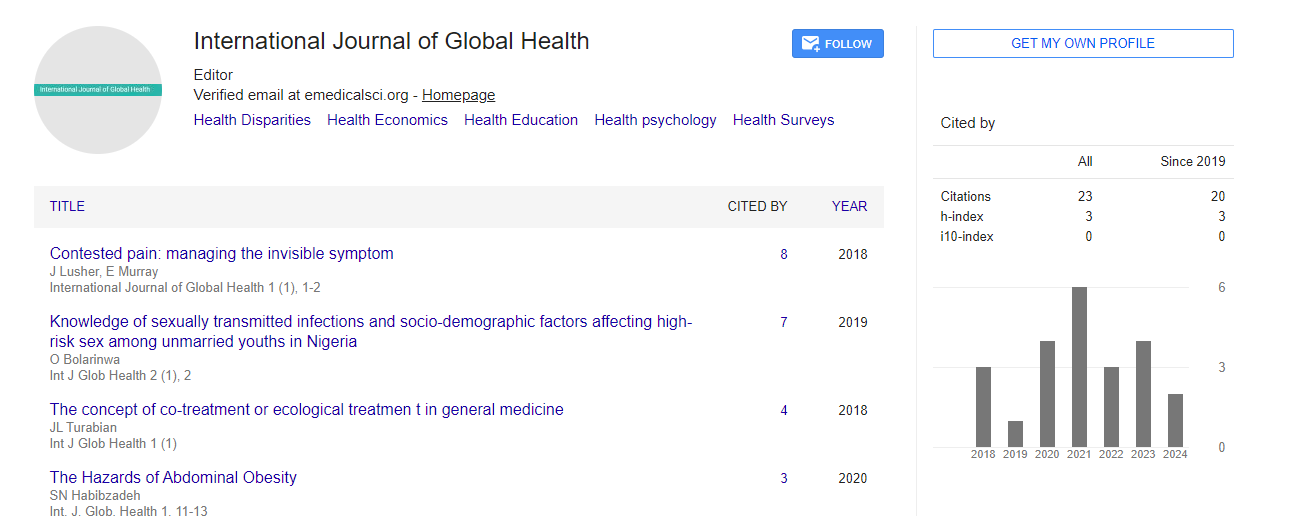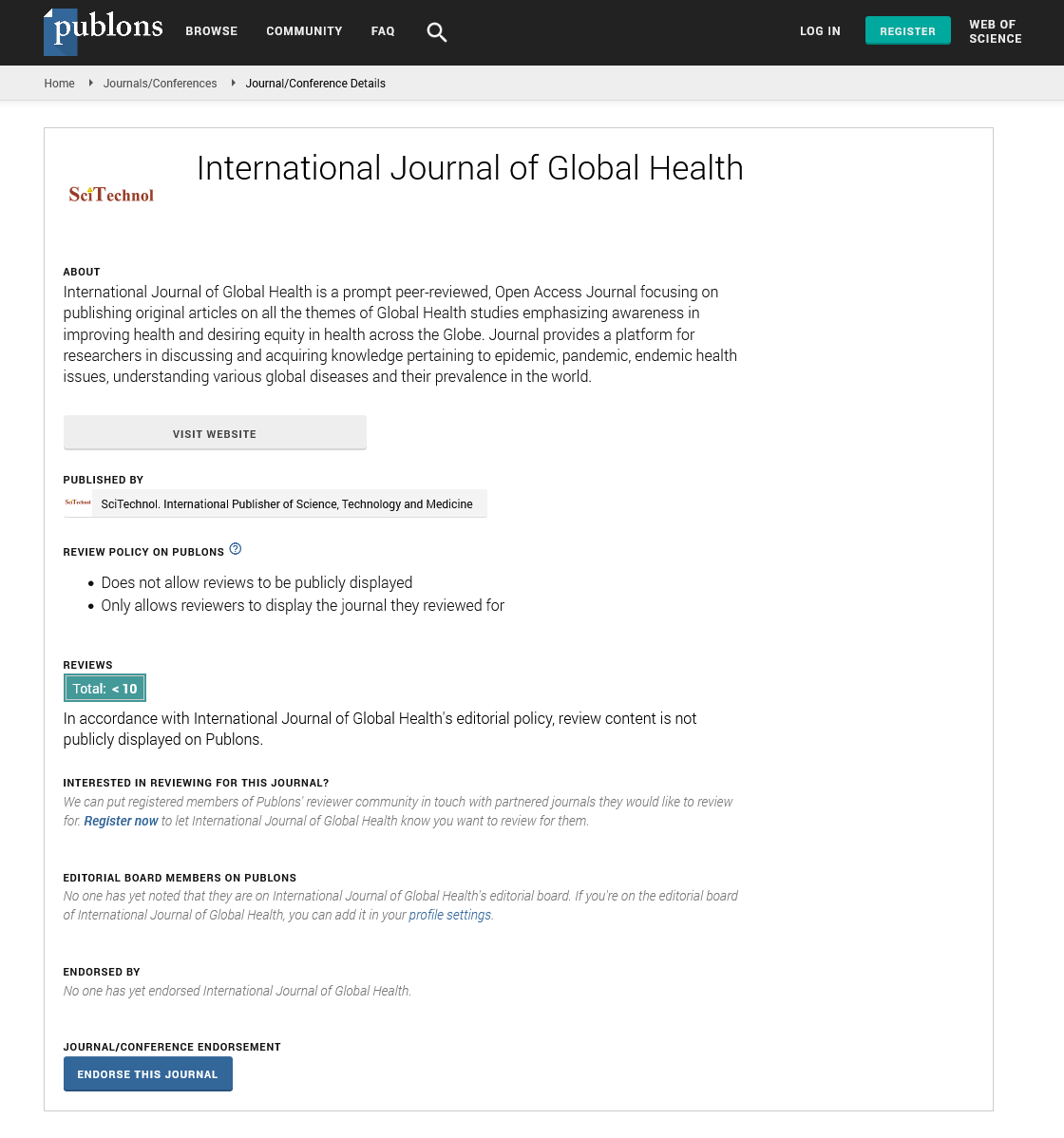Opinion Article, Int J Glob Health Vol: 6 Issue: 3
A Retrospective Study on Demographic Variations and Mortality Rates
Isabelle Dupont*
1Department of Wildland Resources, Utah State University, Logan, United States of America
*Corresponding Author: Isabelle Dupont,
Department of Wildland Resources,
Utah State University, Logan, United States of America
E-mail: isabelle.dupont@usu.edu
Received date: 28 August, 2023, Manuscript No. IJGH-23-116156;
Editor assigned date: 30 August, 2023, PreQC No. IJGH-23-116156 (PQ);
Reviewed date: 13 September, 2023, QC No. IJGH-23-116156;
Revised date: 21 September, 2023, Manuscript No. IJGH-23-116156 (R);
Published date: 29 September, 2023, DOI: 10.4172/Ijgh.1000187
Citation: Dupont I (2023) A Retrospective Study on Demographic Variations and Mortality Rates. Int J Glob Health 6:3.
Description
Mortality rates are crucial indicators of public health and provide valuable insights into the well-being of populations. Demographic factors, such as age, gender, ethnicity, and socioeconomic status, can significantly influence mortality rates. This retrospective study aims to investigate the relationship between demographic variations and mortality rates, shedding light on disparities in health outcomes among different demographic groups.
The study utilized a comprehensive dataset comprising mortality records collected over a specified time period. These records included information on age, gender, ethnicity, socioeconomic status, cause of death, and geographic location.
The study included a diverse study population, representing various demographic groups within the target region or population. Individuals of all ages were considered, allowing for a comprehensive analysis.
Variables of interest
Demographic variables: The study examined the influence of the following demographic variables on mortality rates:
Age: Participants were categorized into age groups, such as children, young adults, middle-aged adults, and seniors, to assess agespecific mortality rates.
Gender: Mortality rates were compared between males and females to identify gender-based disparities.
Ethnicity: Ethnicity was considered to explore variations in mortality rates among different ethnic groups.
Socioeconomic status: Socioeconomic indicators, such as income, education, and occupation, were used to assess mortality differences between socioeconomic strata.
Data analysis
Descriptive statistics: The study began with descriptive statistics, such as mean age at death, median survival times, and mortality rates by demographic variables.
Mortality rate calculation: Mortality rates were calculated as the number of deaths per 1,000 individuals or per 100,000 individuals, depending on the size of the study population.
Comparative analysis: Comparative analyses, including chisquared tests, t-tests, and regression analysis, were employed to assess the statistical significance of mortality rate variations across demographic groups.
Survival analysis: Kaplan-Meier survival curves and Cox proportional hazards models were used to analyze survival patterns and assess the impact of demographic factors on mortality risk.
Ethical considerations
The study adhered to ethical principles, ensuring the privacy and confidentiality of individuals' health data. Informed consent, where applicable, was obtained, and all data handling practices complied with relevant regulations.
The study revealed significant findings related to demographic variations and mortality rates. It provided insights into age-specific mortality patterns, gender disparities, ethnic differences, and the influence of socioeconomic status on mortality outcomes. Additionally, the study identified the leading causes of death within the population and their demographic associations.
The study's findings in the context of public health and healthcare policy. It explored the implications of demographic variations in mortality rates, addressing potential interventions and strategies to reduce health disparities among different demographic groups. Recommendations for future research and policy initiatives were also discussed.
The study's findings highlighted several key insights
Age-specific mortality rates indicated higher mortality among the elderly population, emphasizing the need for geriatric care and support.
Gender disparities in mortality rates were observed, with males showing higher rates in certain age groups, warranting gendersensitive healthcare approaches.
Ethnic variations in mortality rates underscored the importance of culturally tailored healthcare interventions and outreach.
Socioeconomic status significantly influenced mortality outcomes, with lower socioeconomic groups facing higher mortality risks, calling for targeted interventions to address health inequalities.Conclusion
This retrospective study on demographic variations and mortality rates contributed to our understanding of the complex interplay between demographic factors and mortality outcomes. By identifying disparities and risk factors, the study informed public health efforts aimed at improving overall population health and reducing mortality differentials among diverse demographic groups. It emphasized the importance of evidence-based policies and interventions to address these disparities and promote equitable healthcare access and outcomes for all.
 Spanish
Spanish  Chinese
Chinese  Russian
Russian  German
German  French
French  Japanese
Japanese  Portuguese
Portuguese  Hindi
Hindi 
